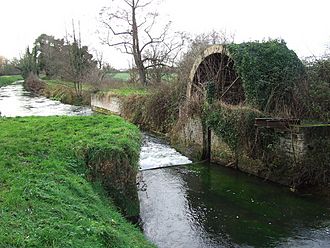Narborough Bone Mill facts for kids
Quick facts for kids Narborough Bone Mill |
|
|---|---|

The waterwheel of the Narborough Bone Watermill
|
|
| General information | |
| Type | Watermill |
| Location | River Nar |
| Town or city | Narborough |
| Country | England |
| Coordinates | 52°40′58″N 0°33′39″E / 52.68278°N 0.56083°E |
| Opening | c. 1820 |
The Narborough Bone Mill was a special kind of watermill in England. It used the power of water to grind bones. It was located in Norfolk, near the village of Narborough, right on the River Nar. This mill was built around 1820. Records show that the Marriott Brothers owned it in 1830. They also controlled the river for boats.
Today, the Munford family owns the mill site. They are working to preserve it. They received a grant to help with this important work. You can find more information at bonemill.org.uk.
How the Mill Worked
This watermill had a unique job. It turned animal bones into fertilizer for farms. The bones came from local places where animals were slaughtered. They also came from the whaling industry.
Bones were brought to the mill by barge on the River Nar. They came from a factory in Lynn, about 1 mile (1.6 km) away. This factory processed whale blubber. Another mill, Congham watermill, was 7.5 miles (12.1 km) north. Whales were taken there by horse and cart for processing. Then, their bones were brought to Narborough.
Both mills were in quiet, remote areas. This was probably because of the strong smell they created. The Narborough mill did not need to be near a road. Both its raw materials and finished products traveled by horse-drawn barge. The River Nar was opened for boats in 1759. It was used to carry things like coal and grain.
Making Bone Fertilizer
We don't have exact details of how bones were processed at Narborough. But the usual way was to first boil the bones. This made them brittle and removed the fat. The fat was then skimmed off. It was used for things like grease for coaches and carts.
Next, the bones were either chopped by hand or put through a machine. This machine had a toothed cylinder. Both methods broke the bones into smaller, easier-to-handle pieces. Finally, the millstones, powered by the waterwheel, ground the bones into a fine powder. This powder was the fertilizer.
An Unusual Use for Bones
At one time, this bone mill was used for a surprising purpose. Bones from old cemeteries and burial grounds in Hamburg, a city in Germany, were shipped to King's Lynn. From there, they were taken to the Narborough mill. They were also processed into agricultural fertilizer.
At the time, people did not question this practice. It was believed that "One ton of German bone-dust saves the importation of ten tons of German corn." This meant using bone fertilizer helped grow more food locally.
Why the Mill Closed
In 1884, the Nar Valley Drainage Board bought the rights to use the River Nar for boats. Soon after, they built a sluice. This structure stopped boats from traveling further on the river. The mill stopped making fertilizer a few years later. This was likely because boats could no longer bring materials.
In 1915, the watermill buildings were still standing. But over the next few years, they were slowly taken apart. The machinery was sold for scrap metal. Most of the rubble was used to build farm tracks.
Today, only a few parts of the mill remain. You can still see the large waterwheel, which is 16 feet (4.9 m) across. There are also parts of the main mill building's wall. In 2015, work began to fix up the waterwheel. This was possible thanks to funding from the Heritage Lottery. For more information, you can visit bonemill.org.uk.

